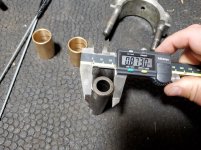ElginAgain
Plastic
- Joined
- Jun 8, 2018
I'm in the process of rebuilding my Quincy QR-25, model 340 (ROC 31) and as the title suggests, I'm having clearance problems with some aftermarket bushings for the connecting rod to piston pin. I can't even get the pins to fit into the bushings with them loose, and once they're pressed into the rods, the ID of the bushing will be even tighter.
I realize that digital calipers are not the best tool for this job, but they're all that's available. The ID's of the new bushings are 0.8730" and 0.8725". The OD of the piston pins is 0.8730" for the high pressure and the low pressure is 0.8735" at the end and 0.8730" in the center. So basically, the bushings are exactly the same size or slightly smaller than the pins. The assembly specs for this machine state the clearance to be .0004" to .0009".
The manufacturer of the aftermarket bushings says I'll need to install them in the rods, then have them honed to fit the pins. I had originally considered using a brake cylinder hone to accomplish this, but then realized that I can't even measure accurately enough to determine if I've got the proper clearance, so I'd likely have to hire this out to a machine shop. I'm wondering though, if I purchased genuine Quincy bushings, if this extra step would be necessary or if they'd be made so precisely that all I'd need to do is press them into the rods and the pins would just fit right (assuming my pins aren't worn).
I'd also like to get some feedback on the idea of reusing the old bushings, which I've "measured" to have 0.003" clearance over the pins. That's more than 3x the specification, so I'm guessing it would be a waste of time to re-install and just see how long they last, but I'd like to get the experts opinions on this.
I realize that digital calipers are not the best tool for this job, but they're all that's available. The ID's of the new bushings are 0.8730" and 0.8725". The OD of the piston pins is 0.8730" for the high pressure and the low pressure is 0.8735" at the end and 0.8730" in the center. So basically, the bushings are exactly the same size or slightly smaller than the pins. The assembly specs for this machine state the clearance to be .0004" to .0009".
The manufacturer of the aftermarket bushings says I'll need to install them in the rods, then have them honed to fit the pins. I had originally considered using a brake cylinder hone to accomplish this, but then realized that I can't even measure accurately enough to determine if I've got the proper clearance, so I'd likely have to hire this out to a machine shop. I'm wondering though, if I purchased genuine Quincy bushings, if this extra step would be necessary or if they'd be made so precisely that all I'd need to do is press them into the rods and the pins would just fit right (assuming my pins aren't worn).
I'd also like to get some feedback on the idea of reusing the old bushings, which I've "measured" to have 0.003" clearance over the pins. That's more than 3x the specification, so I'm guessing it would be a waste of time to re-install and just see how long they last, but I'd like to get the experts opinions on this.










